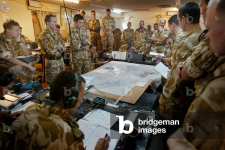....
The US envisages deploying the Multi-Domain Task Force ahead of the "Conventional" Forces. It is to be deployed to manage Competition, Conflict and Crisis, or the full spectrum of conflict or Krulak's three block war.
It's playbook includes soft-kill capabilities as well as hard-kill capabilities. That means that it can counter low level incursions, hybrid incursions and, with the Long Range Precision Fires, as well as the Air Defence capabilities, the ability to counter, at range, with lethal force, the occasional, small scale surprise incursion from air, sea or land.
Those capabilities allow the MDTF to act as a screening force that maintains contact with the enemy's probing attempts and to manage the follow on forces that might be called for.....IMO.
To me that means that a Canadian national MDTF, manned by the Army 24/7, in conjunction with the Maritime Component Commanders and the Joint Force Air Component Commander, under CJOC, would be positioned to materially assist with the day to day defence of Canada and would be equipped with a powerful back stop capability, in the form of the missile forces. I am regularly told that there is no need for such a capability because the RCAF has it handled under NORAD. But, following that philosophy, 4 CMBG would have been able to rely on the RCAF and had little need for the RRCA. I lean more towards a belt and braces solution to ensure an all-weather, all-aspect capability. And I believe that is what the MDTF leans into generally in any event. It becomes a key element in an Integrated Air Missile Defence.
I believe that it also parallels the resurrection of interest in the air space by all armies, but especially NATO ones.
....
Successive Chiefs of Defence Staff, often infanteers themselves, have promoted the notion of the infantry-centric Canadian Army.
Infantry soldiers are the Canadian Army’s primary combat fighters and are responsible for engaging the enemy.

forces.ca
The tendency is to think of the infanteer as the ultimate response to any situation.
I'm inclined to think of the infanteer as the last resort. If the situation has degraded to the extent that close combat is required it seems to me that a whole lot has gone wrong. The enemy has got past diplomats and politicians, sensors of all sorts, navies and air forces, missiles and bombs and guns, and even tanks. And even Special Forces.
The infantry represents the people of Canada. It is the human resources of the nation converted to a wartime capability. If the government is having to choose between putting its people into the firing line or maintaining the tax-producing economy on which those people rely, the situation in which the Ukrainians and the Russians find themselves, then things have indeed gone pear-shaped.
To me it makes more sense to build our National Defence outwards from the support and plan to send bullets before bodies. And, to paraphrase, I believe, Jackie Fisher, see the infantry as a missile to be launched. Ideally the last missile.
...
Now, 6 to 12 Battalions with 2 or 3 companies each (including RCAC Regiments) is actually not a heavy commitment for a nation the size of Canada. Those 12 to 36 sub units would arguably be equivalent to the Special Forces of many nations.










